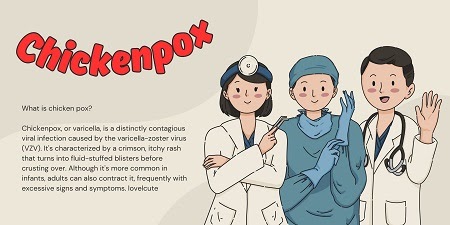Chickenpox, or chickenpox, is a highly contagious viral infection caused by the varicella-zoster virus (VZV). It is characterized by a dark red, itchy rash that turns into fluid-filled blisters before scabbing over. Although it is more common in infants, adults can also contract it, often with excessive signs and symptoms. cute
Key facts about chickenpox:
- logo
- fever
- Fatigue and loss of appetite
- Headache
Itchy rash that spreads over the body in layers: dark red spots → blisters → scabs.
infect:
Spread through direct contact with rash.
Airborne transmission is through coughing or sneezing.
The rash is relatively contagious 1-2 days before it appears until all blisters have scabbed over. Increase hemoglobin
Headache:
Secondary bacterial infection of pores and skin.
pneumonia.
In rare cases, encephalitis (infection of the brain) can occur.
The situation is especially serious for adults, pregnant women and people with weakened immune systems.
prevention:
The chickenpox vaccine is the most effective way to prevent the disease.
Avoid close contact with people who have inflammation.
Precise hygiene practices (e.g. washing fingers).
remedy:
Use calamine lotion, antihistamines, and oatmeal baths to treat symptoms.
Acetaminophen (acetaminophen) is used to reduce fever (stay away from aspirin as it may cause Reye’s syndrome).
For severe cases or high-threat groups, antiviral medications may be prescribed.
Chickenpox usually resolves on its own in about 1-2 weeks, but vaccination and early care can prevent complications.
What are the main signs?
The main signs and symptoms of chickenpox may vary slightly for men or women, but usually include the following:
1. Fever
Usually the main symptom.
The range may also range from medium to advanced.
2. Fatigue and discomfort
The overall feeling is that I am sick.
Loss of appetite and fatigue are common.
three. Rash (main symptom)
What starts out as small red spots turns into fluid-filled blisters.
Sooner or later, the blisters will dry out and crust over.
Rashes are divided into 3 grades:
Red spots: First appear on the chest, waist, or face and may spread to other parts of the body.
Blisters: filled with cleaning fluid and often itchy.
Scab/Scab: The structure of broken and dried blisters.
Four. itching
The rash is accompanied by intense itching, which may lead to scratching and secondary skin infection.
5. Headache
Fever may also be accompanied by a mild to mild headache.
6. Lack of appetite
Commonly seen in the early stages of contamination.
7. Sore throat or cough
Moderate respiratory symptoms may appear earlier than the rash.
Flag level:
Incubation period (10-21 days): There are no obvious signs and symptoms, but the virus is in the body.
Prodromal phase (1-2 days before rash): Fever, fatigue, and general malaise begin.
Extent of rash (5-10 days): Expanding spots, blisters, and scabs.
Severe signs and symptoms and headache (less common):
A high fever that lasts for several days.
Infected pores and skin lesions (dark red, swollen, or filled with pus).
Difficulty breathing (indicating pneumonia).
Confusion or excessive headache (should be a sign of encephalitis).
If you have severe symptoms or have questions (for example, chickenpox in pregnant women, newborns, or people who are immunocompromised), try to find scientific evidence right away.
What are the complications?
Complications of chickenpox are uncommon in healthy individuals but can occur, mostly in high-incidence children, pregnant women, adults, or individuals with weakened immune systems. Here are some potential complications:
1. Bacterial skin infection
Motivation: Scratching an itchy rash can damage pores and skin, allowing bacteria to get inside.
Effect:
Cellulitis (deeper pores and skin contamination).
Impetigo (a surface contamination that causes sores and scabs).
Scarring or abscess formation.
two. Pneumonia (varicella pneumonia)
**More common in adults, pregnant women, and immunocompromised people.
symptom:
- cough.
- Chest pain.
- Shortness of breath.
- three. Encephalitis (congenital infection)
- Uncommon but serious problem.
- Signs and symptoms:
- Severe headache.
- Confusion or disorientation.
- Seizures.
Four. Reye’s syndrome (associated with aspirin use)
This occurs when aspirin is used to treat fever or pain in children with chickenpox.
Signs and symptoms:
Behavioral changes.
Liver and genius damage (certainly fatal).
five. Shingles (herpes zoster)
Cause: The varicella-zoster virus lies dormant in the body and may reactivate later, causing a painful rash.
6. Bloodstream infection (sepsis)
If bacteria from pore and skin infections enter the bloodstream, life-threatening sepsis can result.
7. Dehydration
Severe vomiting or diarrhea can lead to dehydration, especially in children.
eight. Headaches sometimes occur during pregnancy
If smaller during pregnancy, chickenpox can cause:
Congenital varicella syndrome: Birth defects including low initial weight, limb abnormalities, and neurological problems.
Miscarriage or stillbirth: Especially if the infection occurs early in pregnancy or in the second month of pregnancy.
Severe neonatal chickenpox: If the mother is infected with chickenpox shortly before transport, the baby may be born with severe or even fatal chickenpox.
9. Eye infection
Blisters around or inside the eyes can also cause vision problems or permanent damage if left untreated.
A troublesome high-risk company
Pregnant girl.
Newborn.
Older adults.
Immunocompromised individuals (e.g., chemotherapy patients, transplant recipients, HIV/AIDS patients).
Adults with no previous immunity.
Prevention and early intervention
Vaccination: Very effective in reducing the chance of chickenpox and complications.
Antiviral drugs: such as acyclovir, are recommended for extreme cases in high-risk ventures.
Causing scientific concern: Excessive fever, difficulty breathing, or neurological symptoms.
Seeking medical interest
The rash can become red, swollen, or filled with pus (symptoms of secondary infection).
Chronic high fever.
Difficulty breathing or severe coughing.
Excessive headaches or unusual behavior (such as confusion, seizures).
Get vaccinated and protect your child today!
Vaccination is the most effective way to protect your baby from chickenpox, a highly contagious disease that can cause pain, missed school time, and possibly serious complications.
Why vaccinate?
Safe and powerful: Chickenpox vaccine prevents excess illness in more than 90% of cases.
Fewer Complications: Prevent dangerous outcomes like skin infections, pneumonia, and encephalitis.
Internet Immunization: Helps prevent the spread of chickenpox to those who are susceptible, such as newborns or immunocompromised people.
Should your child be vaccinated?
First dose: At 12-15 months of age.
Second dose: Between 4-6 years of age.
Benefits of Vaccination
Minimize itching and scarring caused by rashes.
Prevent school absences and parent drawing disruptions.
Reduce the threat of shingles developing later.
Protect your family, protect your community
By deciding to get vaccinated, you can provide your children with a safer, healthier future while supporting the reduction of the spread of chickenpox in your network.


.jpg?ezimgfmt=ng%3Awebp%2Fngcb12%2Frs%3Adevice%2Frscb12-1)



